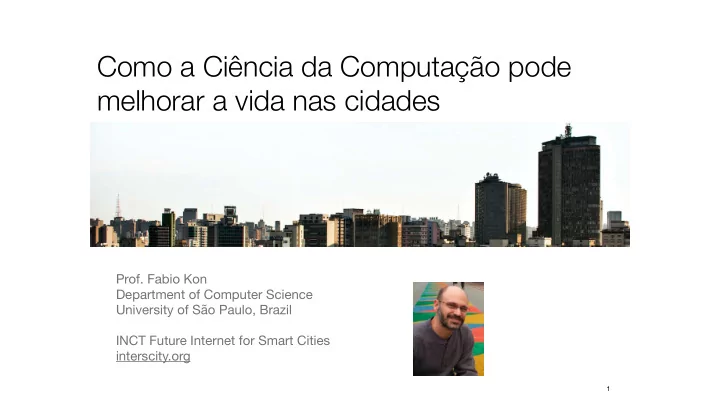

Como a Ciência da Computação pode melhorar a vida nas cidades Prof. Fabio Kon Department of Computer Science University of São Paulo, Brazil INCT Future Internet for Smart Cities interscity.org � 1
We live in cities • old methodology: ~55% of the people (UN) • newer methodologies: >80% (European Commission) • Satellite images • Image Processing / Machine Learning • Population databases � 2
Urban public policies • Most of the times: • Designed with no scientific basis at all • A few times: • Based on methods and technologies from the XX century � 3
Evidence-based public policies 1.Create and collect rigorous scientific evidence of what works, including costs and benefits 2.Monitor the execution of programs and measure the impact 3.Use scientific evidences to improve the programs, increase their scale and cancel the programs that don’t work. 4.Promote innovation and test new approaches. � 4
INCT InterSCity Collaborations • 35 Computer Science professors + • Architects, Urban Planners, Economists, Health Professionals, Transportation Engineers • City governments (unfortunately, very weak collaboration) � 5
InterSCity lab in Brazil ~60 people working: • USP , PUC-Rio, Scipopulis, UFABC, UFG, UFMA, UFMS, UFRJ, Unicamp, FGV, Unifesp • FAPESP / CNPq / CAPES (2017 to 2023) • InterSCity.org • Open Source software • Open Datasets � 6
Our view Smart City = "a city in which its social, business, and technological aspects are supported by ICT to improve the quality of life of its citizens in an integrated, a ff ordable, and sustainable way.” we’re interested in developing a Software platform for Smart Cities � 7
Our view on Smart Cities Although we don’t ignore high-tech solutions for the elite, we prefer to focus on: • people (technology is a means not an end) • low-income populations • developing countries • underprivileged neighborhoods � 8
The InterSCity Project • 3 lines of research • 3 levels � 9
Projects 1. Smart City Software Platform 2. City Simulator 3. Health Dashboard 4. Accessibility Ranking 5. Scipopulis Startup 6. BikeSCience @ MIT Senseable City Lab � 10
1 - A generic Software Platform for Smart Cities � 11
Survey and proposed reference architecture for Smart City Software Platforms � 12
� 13
Exemplos de uso da plataforma Smart Parking APP single-page app that helps users in the hard task of finding available parking spots around the city. It used the platform services to access simulated data. � 14
Exemplos de uso da plataforma � 15
Outdoor Sports Map � 16
Other uses • Smart City Hackathons • Graduate Course at USP • Undergraduate Course at UFMA • Research (MSc, PhD, and post-doc @ USP/Puc-Rio/UFMA) • In the future: real cities? � 17
2 - InterSCimulator • Erlang-based large-scale simulator for Smart Cities • Simulations with 17 million agents in super-real-time • Multimodal transportation • cars, pedestrians, buses, subway, (bicycles). • Impact analysis of changes in the transportation infrastructure and associated costs. • Population from Paraisópolis favela (slum) in SP . � 18
3 - � 19
� 20
Multiple ways of dividing the city � 21
Leukemia HIV Dengue Fever � 22
Metropolitan Hospital Regional Hospital � 23
Hypertension (most frequent) >20Km to get service � 24
Health Dashboard Challenges • At the moment it’s a useful interactive tool for the public health professional • But can we automate part of the work? • Using ML to detect different patterns for different kinds of diseases? • Using AI to trigger warnings to health officials? • Develop models to support long-term planning? � 25
4 - Crowdsourcing startup App: guiaderodas � 26
Accessibility Ranking � 27
� 28
Scipopulis’ COLETIVO APP (for citizens)
REAL TIME DASHBOARD (for system operators) • In use by the São Paulo secretary of transportation • in test at: Rio de Janeiro, Curitiba, Santiago (Chile), Brasilia, etc.
MOBILITY PANEL (CONSOLITADED BUS SPEEDS for citizens)
DATA ANALYSIS and visualization Historical data Comparing bus x auto
BikeScience w/ MIT Senseable City Lab • Use of bikes for urban transportation is increasing • 18+ million shared bikes, increasing rapidly • Bike transportation has numerous advantages: • for the city • for the planet • for the user • But it is highly under-utilized � 33
How can we foster cycling as a serious means of urban transportation Road Geography Economy Climate Culture Infrastructure Topology OTHER City CYCLING MEANS OF TRANSPORTATION Private Sharing Personal fleet User Dock Dockless Bike sharing Companies Commuting Leisure Tourism Errands � 34
Bike Data Science • Analyzing millions of bike trips from 20 cities • Starting with Greater Boston (and São Paulo) • Dock-based vs. Dockless • Greater Boston: • 8 million trips since 2011 � 35
Boston bike-sharing evolution � 36
Descriptive Statistics � 37
Bike Mobility Flows � 38
Supporting Public Policy: Flow popularity and infrastructure investments Tier 4: 18 flows 1% of flows Total: 1629 different flows Tier 3: 46 flows 3% of flows Tier 2: 119 flows 7% of flows Tier 1: 1446 flows - 89% of flows � 39
Profile of Speeders ( >15Km/h - euclidean distance) • 4.5% of trips • 90% are men / 10% are women • 50% of them are between 18 and 30 years old • They are present in all age ranges under 52… • but higher tendency to drive dangerously fast: 25 to 30 • Speedy trips length is 20% longer • (they might speed because they need to go farther away) • Speedy trips duration is half of the average (they want to get there quickly) • A subscriber (normally a resident) is 5 times more likely to be a speeder than an isolated customer (normally a tourist) � 40
The Future • Advanced collaborative research among InterSCity partners • Middleware implementation: scalability, performance, usability by developers • Big Data processing, analysis, and visualization • Machine Learning to improve city services • Establish and strengthen collaborations � 41
Contact kon@ime.usp.br interscity.org (PhD and post-doc fellowships available) � 42
Recommend
More recommend